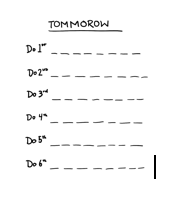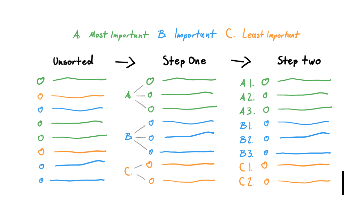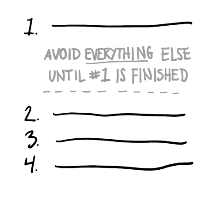You have done the work of capturing and organizing all your tasks. Now it is time to figure out what should come first and next, so you attain optimal results for you, your team, and your organization.
Here are some popular systems for prioritization:
1. Eisenhower Matrix. Former US President Dwight Eisenhower developed this tool. It is a simple four-quadrant box that helps you separate important and urgent tasks. Most of us fall into the trap of thinking urgent is important, but there is a big difference. This propensity likely has roots in our evolutionary history; our ancestors concentrated more on short-term concerns than long-term strategy. This is because tending to an immediate stimulus like a charging saber-toothed tiger could mean the difference between life and death.
In basic terms, urgent tasks are things that feel like they require your immediate attention. They can put us in reactive mode, marked by a defensive, negative, hurried, and narrowly-focused mindset. Think about an email that has to go out in the next 30 minutes, we could feel a little rushed and stressed and maybe will not put the kind of work into it that we would like. Additionally, it could be an email that we have to do, which is not necessarily central to our goals.
There are two common reasons why urgent tasks occur.
· First, it can be related to your poor planning. For example, you just finished a meeting and have five deliverables, but you forget to write them down. About an hour before the next meeting, you remember those tasks and become frenzied to complete them. This is the type of urgency that can be fixed with more solid planning.
· Second, it can relate to other people’s poor planning that puts you in a situation where you have to now react to their demands. Perhaps your teammates drop in and request information within the next hour. Just because something is urgent for them does not mean it is significant to you. Of course, emergencies arise, and it is always good to band together in times of crisis and support the team, but if this is more the case of poor planning and less of a pop-up situation, it should be addressed. Having a system to deal with these two common causes of urgent tasks will be helpful.
Important tasks are ones that are supporting your long-term purpose, mission, values, and goals. They are tasks that inspire you. While some important items can be urgent, Eisenhower believes, “What is important is seldom urgent and what is urgent is seldom important.” Most people spend a lot of their time managing situations and crises by reacting to other people’s priorities stemming from poor planning.

Once you have created your matrix and listed all your items in the respective quadrant, you can then behave accordingly.
· Important and urgent (Q1): Do these tasks as soon as possible.
· Important, but not urgent (Q2): Decide when you will do these and schedule it.
· Urgent, but not important (Q3): Delegate these tasks to someone else.
· Neither urgent nor important (Q4): Drop these from your schedule as soon as possible and never look back.
The goal is to have a few items in Q1 because this quadrant is about putting out fires and dealing with tight timelines. It does not serve anybody to have a sense of panic around completing an item. The more time you dedicate to effective planning, the more you will notice that in about a month or so, you will have fewer items in Q1.
2. Ivy Lee Method or the Tomorrow List. This strategy is a way to rank your urgent and important work by its true priority. The Ivy Lee method dates back to 1918, when Ivy Lee, a productivity consultant, was hired by Charles M. Schwab, the President of the Bethlehem Steel Corporation, to improve his company’s efficiency. As the story goes, Lee offered his method to Schwab for free, and after three months, Schwab was so pleased with the results he wrote Lee a check for $25,000, worth $400,000 today.
Here’s how it works:
1. At the end of each workday, write down the six most important tasks you need to accomplish tomorrow. Do not write more than six.
2. Prioritize those six items in order of their importance.
3. When you arrive tomorrow, concentrate only on the first task. Only when you are finished, should you move to the next one.
4. Approach the rest of your list in the same fashion. At the end of the day, move any unfinished items to a new list of six tasks for the following day. Repeat this process every working day
When you spend time in the evening creating this “Tomorrow List,” it has several benefits:
· Studies indicate that writing down our goals and tasks helps us relax and declutter our minds. The more we free our minds, the less we worry about when we try to fall asleep.
· While sleeping, we can subconsciously be thinking about the goals and problems awaiting us, and our mind can go to work solving problems and forging new insights that can be carried forward for the following day and prime us to take action.
· When we are focused on our plans for the next morning, we save time thinking about what’s first on the docket.
· Limiting ourselves to six daily tasks (or less depending on preference) creates a constraint that forces us to prioritize appropriately and then stay focused by single-tasking our way through the list.

3. ABCDE Method. This technique developed by Brian Tracy helps further divide the most important from a list of already important items.
Here’s how it works:
1. Go through your list and give every task a letter from A to E. Letter A being the highest priority because if you do not complete it, it can have serious consequences.
2. For every task with an A, give it a number that dictates the order you will do it in – A1, A2, A3. B are tasks that you should do, but have somewhat important consequences. Ideally, you should not move on to a B task until you have completed all the A tasks. C tasks are ones that may have mild consequences.
3. Repeat until all tasks have letters and numbers.
The power of this prioritization technique lives in its simplicity and precision. It allows you to get clarity on what is truly important to you because you have to decide what goes in the B3 category v. the C1.

4. Eat that Frog or “Hardest Item First” Method. Once you have prioritized your most important work using whichever preferred method, it’s time to choose how to attack the day.
Many productivity experts including Brian Tracy suggests doing the most important or most laborious task right away because it will set the tone for the rest of the day. Mark Twain famously wrote, “If you have to eat a live frog, it does not pay to sit and look at it for a very long time!” After you eat the frog, you will have the satisfaction that you have already done the worst and hardest thing for the day, and everything else will seem easier. That emotional payoff can spark inspiration and confidence to tackle other tasks. For those who consider themselves early birds, it makes sense to do your most challenging item first because you have a tank of fresh energy in which to dedicate.

5. Warren Buffet’s 2-list strategy. This is a way to make sure that you are working on the most important goals. It does not matter how productive you are, if you are going after non-essential goals that are not leading you to your vision, you are not making progress.
As the story goes, Warren Buffet used this process with his personal pilot to help him prioritize his career goals. The first step was to write down 25 life goals, big and small, relating to career, education, family, and anything else worth spending time on. Step two was to circle the top five goals on that list. Any goals not circled, should be ignored, rather than interspersing them in your schedule for when you have time. This is so that you are always working towards those big life goals and not spending your time doing non-trivial items. Be sure to frequently check-in with yourself to make sure your priorities align with your long-term goals.

6. Fran Hauser’s 4 Square Model. Author and Executive Fran Hauser divides her life priorities into four key quadrants: Career, Friends/Family, Me, and World. Each box has the top priorities that cannot be moved because they deliver the greatest joy and align with her lifestyle. 80% of her time is dedicated to those top items, anything else that does not fit into that box, she is prepared to say no. Sometimes it may mean shifting her schedule around so she can ensure that most of her time is spent on these four quadrants. You can also build in some flexibility and take the average of two weeks instead of sticking to a weekly schedule since some weeks are more demanding than others.
Here are some examples of what it can look like:
· Career: Reading books, learning a new skill
· Family/friends: Twice per week family rituals of spending time together such as working on a project or doing something wildly enjoyable together
· Me: Personal development goals – could be exercise, more sleep, eating well, meditation, etc.
· World: Doing charitable or volunteering work
7. Pomodoro Technique. Developed by Francesco Cirillo in the late 1980s as a time management technique that helps you with your priorities. It uses a timer to break down work into intervals traditionally 25 minutes in length, separated by short breaks. Each interval is known as a Pomodoro, named after the tomato-shaped kitchen timer Cirillo used as a university student. This method has been widely used and similar to concepts such as timeboxing.
Here is how it works:
· Decide on the task to be done.
· Set the timer (traditionally 25 mins.) and work on the task
· End the work when the timer rings and put a checkmark on a piece of paper
· If you have fewer than four checkmarks, take a short break 3-5 minutes.
· Once you have completed four Pomodoros, take a longer break (15-30 mins.), reset your checkmark count to zero and begin with step one.
This technique can help you concentrate your energy on a big task you have prioritized that you want to devote at least a couple of hours to make a dent.
There are various systems that will help you prioritize work that will move the needle in your life to a place of fulfillment and meaning. Experiment with the right system for you and get started!
Quote of the day: “The art of being wise is the art of knowing what to overlook.” -William James
Q: How do you prioritize? Which system do you use that may not be listed above?
[The next blog in this series 4/5 will focus on top tips for prioritization]
As a Leadership Coach, I partner with others to get clarity on your priorities, contact me to learn more.


